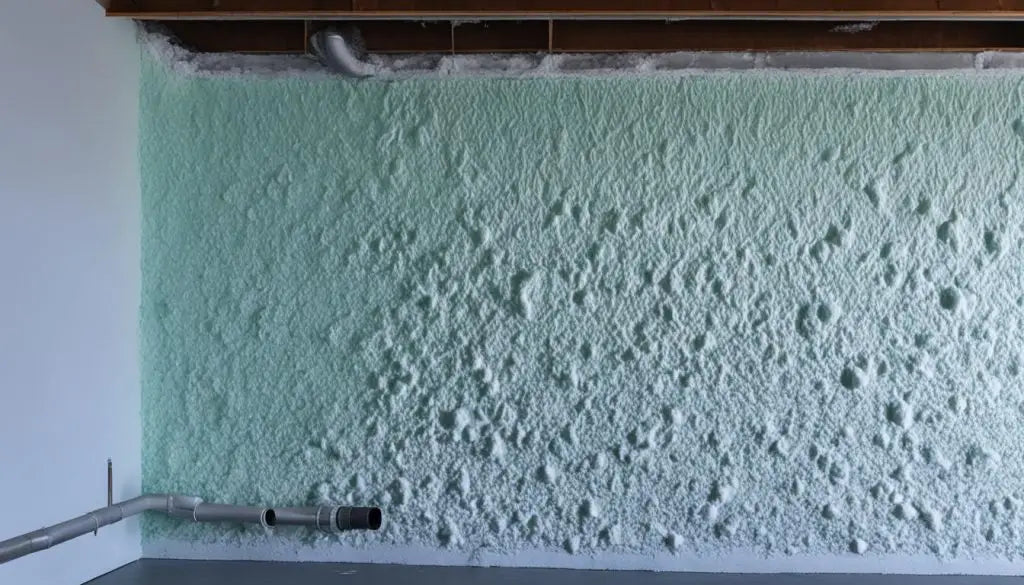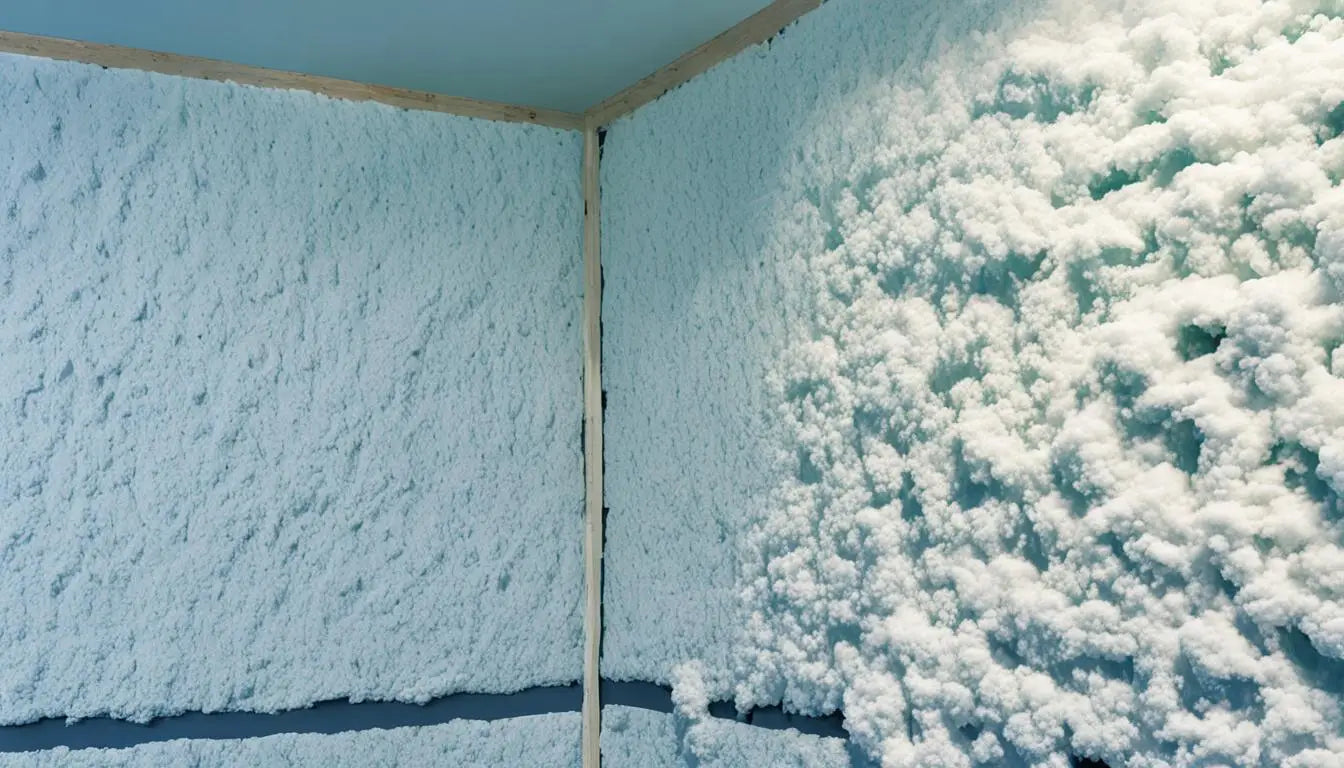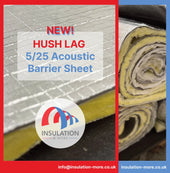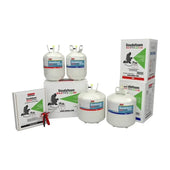Do you know that the air inside your home might hide dangers, like mold, in insulation? Mold thrives on food, temperatures from 4°C to 38°C (40ºF to 100ºF), and moisture
Mold resistance elastomeric foam insulation is seen as the best insulation to resist mold. It's different from the usual fiber ones that can stay wet for 16 days. This high-tech foam insulation doesn't soak up moisture. So, it's great at keeping mold at bay. This is bad news for the 100,000 mold types out there
This advanced technology makes it not just the top choice for resisting mold but also the most lasting one. With it, the worry of high humidity, which can help mold grow in HVAC systems, is gone
Key Takeaways
- Elastomeric foam insulation boasts superior moisture resistance essential for effective mold prevention.
- It is the best tool for combating ubiquitous mold spores in indoor environments.
- High-performance foam insulation's closed-cell structure is key to reducing microbial levels.
- Superior foam insulation for mold resistance provides long-term durability and ease of maintenance.
- Meeting strict industry standards, closed-cell elastomeric foam is the reliable choice for health-conscious installations.
Understanding Elastomeric Foam Insulation and Its Benefits
With the rise of energy-efficient buildings, learning about properties of elastomeric foam insulation is key. This insulation, made of synthetic rubber, works well in many places like homes and factories1. It helps buildings use less energy and stay safe from damage caused by heat and moisture1.
Elastomeric foam insulation has many benefits. In factories, it protects equipment, pipes, and boilers. This keeps the processes running smoothly and saves energy1. Touching very hot surfaces can burn you in seconds. Elastomeric foam keeps workers safe1. It also keeps temperatures steady in water or steam systems, which is good for performance1.
This type of insulation is great for keeping homes warm in winter and cool in summer. It saves energy and money1. It also stops condensation which can cause damage and health problems due to mold1.
Insulation is key for saving energy and reducing harmful gases in both homes and factories1.
Closed cell foams stop air and water from getting through. They work even when wet. Unlike open cell foams, they help things float and keep seals tight in areas like electric and HVAC systems2. Choosing the right insulation is important because of cost, durability, and other factors2.
- Mold Resistance: Closed-cell foam doesn't hold moisture, so it's less likely to get moldy compared to other insulations3.
- Energy Savings: Using this insulation helps keep temperatures right and saves energy in factories1.
- Sound Attenuation: Elastomeric foam is good at stopping noise from machinery1.
- Environmental Benefits: Insulation also helps the environment by cutting down harmful emissions1.
When picking insulation, elastomeric foam is a top choice. It's good for many uses, from homes to industries. It offers comfort, savings, and safety.
Comparing Insulation Types: Elastomeric Vs Fibreglass
Choosing the right insulation is key for saving energy and stopping mold. Experts look closely at elastomeric foam and fiberglass insulation. They consider major differences between the two. This helps them make the best choice for their projects.
Benefits of Closed-Cell Structure in Elastomeric Insulation
Elastomeric foam insulation has great benefits. It's especially good at stopping moisture and mold. Thanks to its closed-cell structure, it blocks water vapour very well.
This is key to avoid mold. Also, it can soak up just 0.2% of water. This proves it's a top choice among insulating materials4. Elastomeric solutions protect against damage and keep insulation working well.
Fibreglass Insulation Pitfalls: Moisture and Mold Risk
Fiberglass insulation has its cons, especially with moisture and mold. It works well for heat and sound but can absorb moisture. This can lead to mold and mildew if it doesn't dry properly4.
Because of its structure, fiberglass needs careful selection in wet areas. It might be cheaper and better at noise reduction. But it could impact the overall insulation performance if mold develops4.
In the UK, professionals aim for solutions that are effective and make buildings healthier. This means looking at how well insulation covers all needs. They think about thermal and sound insulation, moisture risk, and fire safety. All these are crucial for keeping buildings safe and people healthy.
- Fiberglass insulation is better at reducing noise but might get moldy due to moisture4.
- Both elastomeric liners and fiberglass meet emissions standards. But elastomeric liners are better at reducing moisture absorption4.
- Fiberglass is more budget-friendly and easier to handle. Yet, there's a future risk of moisture and mold4.
Closing, when looking at thermal and sound insulation, flame resistance, and moisture control, closed-cell elastomeric foam often wins. It's seen as the better option for lasting insulation success.
Elastomeric Foam Characteristics and Mold Resistance
The unique elastomeric foam insulation characteristics make it an excellent material for fighting mold. Its closed-cell structure stops moisture from coming in. This helps prevent mold from growing.
Elastomeric foam's features like flexibility and durability make it long-lasting. It's also easy to install and maintain. This insulation fits well in different spaces, from homes to industrial sites.
Health and safety are big wins with elastomeric foam insulation. Its mold resistance creates a healthier place to live and work. This approach meets International Standards Organization (ISO) guidelines. ISO aims for safety, quality, and sustainability. Standards like ISO 9001 and ISO 14001 encourage good business practices. They focus on dependable, high-quality materials5.
Cleaning elastomeric foam is simple. This helps keep it mold-free. Such cleanliness benefits those living or working in these spaces.
Mold resistance in elastomeric foam improves indoor air quality. It makes homes and workplaces safer. Everyone can breathe easier and feel more secure.
| Feature | Benefit | Associated ISO Standard |
|---|---|---|
| Closed-cell Structure | Moisture and vapor resistance | ISO 14001: Environmental Management |
| Flexibility and Durability | Long-term performance and adaptability | ISO 9001: Quality Management Systems |
| Mold Resistance | Healthier environments, enhanced air quality | ISO/IEC 27001: Information Security Management |
| Ease of Installation and Cleanliness | Reduced maintenance costs, improved safety | ISO/IEC 42001: Artificial Intelligence Management Systems |
Elastomeric foam insulation meets needs for thermal and moisture control. It supports global standards for better living and environmental care. This balance between material innovation and standards shows why it's a top choice for mold resistance and caring for our planet5.
The Significance of Proper Installation and Maintenance
The strength of buildings and the air we breathe inside depend a lot on how well we install and keep up elastomeric foam insulation. It's not just about putting it in once. Regular checks and fixes help keep insulation working well. This avoids mold growth and damage to the structure.
Ensuring Adequate Insulation Thickness
A key step in building is making sure insulation is thick enough. This stops condensation and moisture buildup. Elastomeric insulation blocks water vapor really well, if used right6. The right thickness is crucial for it to keep heat in or out efficiently.6
The Role of Adhesives and Tapes in Insulation Integrity
Strong sealing is vital for insulation to work properly. This is why adhesives and tapes are so important. They stick insulation materials together and stop air and moisture from getting in. This is essential to prevent insulation from getting worse and to stop microbes from growing.
| Insulation Type | Key Characteristics | Recommended Usage | Inspection Frequency |
|---|---|---|---|
| Elastomeric Foam | Flexible, moisture-resistant, non-latex6 | Indoor pipes, prone to condensation7 | 2-4 times per year7 |
| Mineral Wool | Non-combustible, moisture-resistant7 | Outdoor, high-temperature applications7 | As needed, high-moisture areas more frequently7 |
| Polyolefin | Temperature resistant from -150°F to 180°F6 | Environments with varying temperatures6 | 3-4 times per year, dependent on temperature fluctuations6 |
Keeping the insulation in good shape is key. It needs to be checked 2 to 4 times a year. And it usually needs replacing every 8 to 12 years. This stops problems with condensation. And it makes sure the insulation keeps saving energy and stopping corrosion or mould.7
Mold Resistance Elastomeric Foam Insulation
One key benefit of mold resistance elastomeric foam insulation is its strong defense against mold. There are over 100,000 known mold types8. They can grow both inside and outside8. When humidity is over 60%, mold growth in HVAC systems can increase8. The insulation's closed-cell structure is designed to stop this problem. It is ideal for damp areas.
Elastomeric foam insulation outperforms fibrous glass in keeping environments mold-free8. Fibrous glass can stay wet for up to 16 days. This creates higher microbial levels8. NAIMA advises removing wet fiberglass to prevent mold. Meanwhile, Armacell's elastomeric foam insulation stays dry. It doesn't need frequent replacement8.
Elastomeric foam's closed-cell structure prevents moisture absorption8. This stops mold from forming. It is also easy to clean and passes key tests for resistance against mold and bacteria8. It meets strict standards, including UL181 and ASTM G21/C 1338 for fungi. This proves it's durable and effective against mold9.
This insulation is excellent at blocking water vapor10. K-FLEX product has a vapor rating of 0.03 perm-in. Fibrous materials have a much higher rating of 75.00 perm-in. Good HVAC design and maintenance are important to avoid mold9.
| Material Type | Microbial Resistance | Moisture Absorption | Water Vapor Permeability | R-Value Requirement |
|---|---|---|---|---|
| Elastomeric Foam | High (Meets UL181, ASTM G21/C 1338 and G22) | Low (Does not absorb) | 0.03 perm-in | 4.2 |
| Fibrous Materials | Low (Not recommended if wet) | High (Can hold moisture up to 16 days) | 75.00 perm-in | 4.2 |
In conclusion, mold prevention with elastomeric foam insulation is proven and essential8910. It keeps environments mold-free, which is vital. Mold can damage structures and harm health8. Using elastomeric foam insulation protects buildings and people. It's a wise investment for everyone's safety and building durability.
Ideal Applications for Elastomeric Foam Insulation
The search for the best insulation solutions has spotlighted elastomeric foam insulation. It’s highly versatile, used widely in various sectors. Its properties shine in crucial areas.
Why Choose Elastomeric Insulation for HVAC Systems
Concerns about indoor air quality and energy efficiency have made HVAC systems insulation essential. Kaimann's closed-cell elastomeric foam insulation is GREENGUARD Gold certified. It ensures low emissions and safer indoor environments11. In healthcare, the American Institute of Architects requires air to be fiber-free. This insulation stops contaminants from spreading, unlike fibrous materials11.
AP Armaflex is resistant to mold, fungi, and bacteria. It meets UL 181 standards for Mold Growth. This makes it perfect for HVAC insulation, especially in sensitive places12.

Elastomeric foam insulation keeps itself dry. Just 1% more moisture can drop its efficiency by 7.5%12. It's dust-free, promoting cleaner air flow not only in healthcare but in all types of buildings12.
Cold Water Piping and the Case for Elastomeric Foam Insulation
Insulating cold water pipes is tricky due to condensation and potential system damage. AP Armaflex insulation fights moisture buildup. It's a strong choice for cold pipes1112. This insulation keeps the system running longer, prevents extra work, and lowers health risks from mold11.
Schools and universities are updating their systems for better health outcomes. They're choosing Armacell's elastomeric foam products. Their mold resistance and fiber-free nature protect students' health1112. Waterbury schools switched to closed-cell elastomeric foam to fight mold and moisture12.
Choosing the right insulation for HVAC and plumbing is crucial. Elastomeric foam insulation protects buildings and saves energy. These benefits make it a top choice for smart building management.
Mitigating Health Risks: Mold Prevention with Advanced Insulation Technology
The importance of preventing mold for our health is very clear. Mold exposure can lead to allergies and even serious respiratory issues. Advanced insulation technology is key here. It uses the ecodesign principles from the European Directive 2009/125/EC. These principles help create products that save energy and protect our health13.
Controlling Humidity and Condensation
Keeping humidity in check is crucial for stopping mold before it starts. Studies highlight the benefit of using sustainable materials like palm and soybean oil in foam insulation13. This approach is eco-friendly and good for our health. By focusing on sustainable design from the start, we can effectively prevent mold13.
Health Implications of Mold and Its Prevention
Preventing mold is essential for our well-being. Research into Cradle to Cradle designs by Attia and others show how smart design reduces mold's health risks13. By exploring CO2 as an alternative in foam insulation, we're getting better at controlling condensation. This helps us stop mold from growing13.
| Component | Contribution to Mold Prevention | Impact on Health |
|---|---|---|
| Ecodesign | Minimises energy usage and moisture intrusion | Reduces potential for mold-related health issues |
| Sustainable Materials | Brings in biodegradable and mold-resistant options | Lowers exposure to harmful chemicals and allergens |
| Alternative Blowing Agents | Decreases VOC emissions linked to condensation and mold growth | Improves indoor air quality and respiratory health |
| Circular Economy Design | Enables reuse and recycling, preventing waste buildup | Facilitates healthier living environments with less biological contaminants |
The Comprehensive Guide to Elastomeric Foam Insulation Installation
Installing elastomeric foam insulation improves energy efficiency and stops mould in your space. Our guide will show you how to install this insulation step by step. It also gives you tips for lasting durability and best performance.

Check the area where you'll install the insulation 2-4 times a year. This prevents condensation problems7. In places with lots of moisture, check even more often to spot any damage or issues with the vapour barrier7. Make sure pipe hangers are secure to keep the insulation working well and avoid any squashing or gaps7.
If there are leaks, fix them fast to stop the insulation from getting wet and mouldy7. Clean the area around the insulation to stop debris from causing condensation and mould7. If you see holes, tears, or parts missing from the insulation, replace it to prevent further issues and energy loss7.
When you're installing new elastomeric foam insulation, use the right seals and adhesives. This keeps the insulation dry by blocking moisture7. It's a good idea to re-tape seals every year to maintain the vapour barrier and keep moisture out7.
The type of insulation you choose depends on the environment. Elastomeric duct liners are great for humid areas because they resist moisture and mould well8. But fibrous glass insulation isn't as good because it can hold moisture longer, raising the risk of mould8.
Elastomeric insulation also helps with thermal efficiency. It prevents condensation and corrosion and keeps energy use down by stabilising the temperature of surfaces6. Keeping surface temperatures and moisture balanced is key to avoiding condensation issues7.
Following a regular schedule for re-insulating is crucial. For instance, copper heating pipes should be completely re-insulated every 8-12 years7. This keeps the insulation effective against condensation and maximises energy efficiency and mould resistance.
For the best results, install insulation carefully and maintain it well. This guide offers not just steps but strategies for a high-functioning, energy-saving, and dry environment.
Revolutionary Developments in Mold-Resistant Insulation Products
The world of insulation is changing fast, aiming to stop mold in our homes and offices. The demand for mold-resistant insulation innovations is growing. This is because the market for high-performance polymer foams is expected to reach $122.4 billion by 202114.
These insulation advancements are set to grow further, all thanks to the soaring demand for polyurethane14. This material is celebrated for its top-notch insulation and flexibility. Analysts predict the polyurethane market will see a big jump by 203014.
Innovations in Anti-Microbial Treatments
Recently, the fight against mold has seen exciting progress, especially in anti-microbial treatments. A standout innovation is the use of polyurethane/graphite nanoplatelets. This combination boosts energy storage and controls temperature14. These materials not only insulate but also block microbes, making our living spaces cleaner and healthier.
Long-Term Efficacy of Mold Prevention Features
The focus on keeping mold away for good is getting stronger. Polyurethane rigid foam, with added nanoparticles, is at the forefront. It improves the durability and effectiveness of insulation14. The combo of polyurethane foams with materials that change phase enhances insulation’s ability to prevent mold14.
Now, understanding how structural foam is made is more important than ever14. Knowing about the foaming and polymerizing steps helps make sure the insulation stays anti-microbial over time. This ensures innovations aren’t just temporary fixes but long-term solutions against mold.
In the UK, there's a significant move towards using strong, mold-resistant technologies. Architects, builders, and homeowners are recognizing the real advantages of these new insulation methods. They’re investing in these to protect their buildings from mold and moisture in the future.
Conclusion
In our journey through the latest in insulation, we've seen elastomeric foam insulation shine as a top choice for stopping mold. Its ability to stay dry and fight off mold makes it a go-to for keeping spaces healthy. An in-depth look at elastomeric foam shows it's better than old-school materials. This is because its design keeps out moisture and mold.
We've found that how you use and look after elastomeric foam insulation matters a lot. Putting it in carefully, choosing the right thickness, and using the right glues and tapes cut down on condensation. This keeps mold away. Proper installation also means it keeps warmth in better and lasts longer against mold.
Our final word is that elastomeric foam insulation brings big benefits in fighting mold. It's all about putting it in right and choosing wisely, especially in HVAC and pipes. This approach protects against mold's health risks. Thus, we close our discussion on mold resistance with elastomeric foam, looking forward to more innovations in building for health15.
FAQ
What is elastomeric foam insulation?
Elastomeric foam insulation is a type of rubber that keeps warmth in and moisture out. It's used in heating, cooling, and water systems.
What are the benefits of elastomeric foam insulation?
This insulation saves energy and cuts down on water build-up. It stops mold, reduces noise, and makes the air cleaner indoors.
How does elastomeric foam insulation compare to fiberglass insulation?
Compared to fiberglass, elastomeric foam is better at stopping moisture and mold. Fiberglass is more likely to have these problems.
What characteristics of elastomeric foam insulation contribute to its mold resistance?
Elastomeric foam insulation keeps water vapor out with its tight cell structure. It's also stretchy, strong, and easy to keep clean.
How important is proper installation for mold resistance?
Installing it correctly is key to avoid moisture and mold. The right thickness and sealing are essential.
How does elastomeric foam insulation contribute to healthy indoor air quality?
Its ability to resist mold helps keep the air clean. This reduces health risks from mold.
What are the ideal applications for elastomeric foam insulation?
This insulation is great for HVAC and cold pipes. Its thermal and moisture resistance and durability make it suitable.
Why is mold prevention important for health?
Mold can pose serious health threats. That's why it's crucial to prevent it, keeping environments safe.
What is the significance of humidity and condensation control in mold prevention?
Managing humidity and condensation prevents mold by keeping areas dry. Insulation and moisture management are vital.
What is the comprehensive guide to elastomeric foam insulation installation?
The guide gives detailed steps and tips on how to install insulation properly. It covers surface prep, gluing, and placing insulation.
What are the latest developments in mold-resistant insulation products?
The insulation market is always improving. Now, there are products with anti-microbial treatments to fight mold effectively for longer.
Source Links
- https://www.cedengineering.com/userfiles/T05-004 - Overview of Insulation Materials - US.pdf
- https://www.jbc-tech.com/blog/posts/open-cell-closed-cell-foams-keys-to-making-the-right-selection/
- https://www.armacell.us/fileadmin/user_upload/White_Papers/Armacell_MoldandIAQ.WhitePaper.EN.US.2020.pdf
- https://www.knaufnorthamerica.com/en-us/blog/fiberglass-duct-liner-vs-rubber-duct-liner
- https://www.iso.org/home.html
- https://insulation.org/io/articles/proper-use-and-application-of-flexible-closed-cell-insulation/
- https://www.buildingmaterials.co.uk/info-hub/insulation/preventing-condensation-issues-guide-to-effective-pipe-insulation
- https://www.armacell.us/resources/resources-library/the-facts-about-mold/
- https://insulationinstitute.org/wp-content/uploads/2022/05/The-Facts-About-Mold-Growth-in-Glass-Fiber-Air-Transmission-Systems.pdf
- https://kflex.com/sites/default/files/2022-03/duct_cover.pdf
- https://www.armacell.us/sustainability/indoor-air-quality-iaq/
- https://www.ductandvent.com/Data/components/media/Armaflex_US_Solutions_School_SSB-0011.pdf
- https://www.ncbi.nlm.nih.gov/pmc/articles/PMC9502929/
- https://www.ncbi.nlm.nih.gov/pmc/articles/PMC9572835/
- https://www.ncbi.nlm.nih.gov/pmc/articles/PMC6572697/




















































